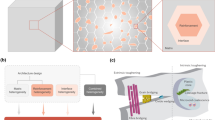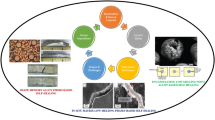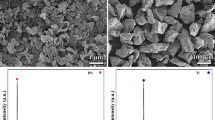Abstract
A set of hierarchical and laminated titanium with optimized mechanical properties and crack tolerance was designed inspired by the substructure of bone. The bone-like Ti with varying load-bearing structures was produced by rolling, annealing, and electron beam local heat treatment. Fibrous-like ultrafine-grained structures are wrapped in the outmost layer as a load-bearing matrix. The internal layer is a laminated structure with periodic medium-sized grains, coarse grains, and fine needle-like grains (hierarchical distribution). Sharp and gradient interlayer interfaces were simultaneously developed. The bone-like structure Ti with higher strength of the outmost layer showed higher strain hardening, which came from the higher strain gradient near the soft layer. The existence of interfaces and soft layers is important for the effective improvement of strain hardening and crack resistance. Analysis of the crack path shows that the present hierarchical and laminated structure Ti showed excellent crack resistance by deflecting the crack propagation path. These observations provide insights into the architectural design and deformation studies of biocompatible materials.
Graphical abstract







Similar content being viewed by others
Data and code availability
Not Applicable.
References
Geetha M, Singh AK, Asokamani R, Gogia AK (2009) Ti based biomaterials, the ultimate choice for orthopaedic implants–a review. Prog Mater Sci 54:397–425. https://doi.org/10.1016/j.pmatsci.2008.06.004
Rack HJ, Qazi JI (2006) Titanium alloys for biomedical applications. Mater Sci Eng C 26:1269–1277. https://doi.org/10.1016/j.msec.2005.08.032
Niinomi M (1998) Mechanical properties of biomedical titanium alloys. Mater Sci Eng A 243:231–236. https://doi.org/10.1016/S0921-5093(97)00806-X
Wu X, Yang M, Yuan F et al (2015) Heterogeneous lamella structure unites ultrafine-grain strength with coarse-grain ductility. Proc Natl Acad Sci 112:14501–14505. https://doi.org/10.1073/pnas.1517193112
Long M, Rack HJ (1998) Titanium alloys in total joint replacement—a materials science perspective. Biomaterials 19:1621–1639. https://doi.org/10.1016/S0142-9612(97)00146-4
Valiev R (2004) Nanostructuring of metals by severe plastic deformation for advanced properties. Nat Mater 3:511–516. https://doi.org/10.1038/nmat1180
Laing PG, Ferguson AB, Hodge ES (1967) Tissue reaction in rabbit muscle exposed to metallic implants. J Biomed Mater Res 1:135–149. https://doi.org/10.1002/jbm.820010113
Perl DP, Brody AR (1980) Alzheimer’s disease: x-ray spectrometric evidence of aluminum accumulation in neurofibrillary tangle-bearing neurons. Science 208:297–299. https://doi.org/10.1126/science.7367858
Rao S, Ushida T, Tateishi T et al (1996) Effect of Ti, Al, and V ions on the relative growth rate of fibroblasts (L929) and osteoblasts (MC3T3-E1) cells. Biomed Mater Eng 6:79–86. https://doi.org/10.3233/BME-1996-6202
Sabirov I, Valiev RZ, Semenova IP, Pippan R (2010) Effect of equal channel angular pressing on the fracture behavior of commercially pure titanium. Metall Mater Trans A 41:727–733. https://doi.org/10.1007/s11661-009-0111-z
Elias CN, Meyers MA, Valiev RZ, Monteiro SN (2013) Ultrafine grained titanium for biomedical applications: an overview of performance. J Mater Res Technol 2:340–350. https://doi.org/10.1016/j.jmrt.2013.07.003
Koons GL, Diba M, Mikos AG (2020) Materials design for bone-tissue engineering. Nat Rev Mater 5:584–603. https://doi.org/10.1038/s41578-020-0204-2
Ritchie RO (2011) The conflicts between strength and toughness. Nat Mater 10:817–822. https://doi.org/10.1038/nmat3115
Koyama M, Zhang Z, Wang M et al (2017) Bone-like crack resistance in hierarchical metastable nanolaminate steels. Science 355:1055–1057. https://doi.org/10.1126/science.aal2766
Liu L, Yu Q, Wang Z et al (2020) Making ultrastrong steel tough by grain-boundary delamination. Science 368:1347–1352. https://doi.org/10.1126/science.aba9413
Zhu Z, Ng FL, Seet HL et al (2021) Superior mechanical properties of a selective-laser-melted AlZnMgCuScZr alloy enabled by a tunable hierarchical microstructure and dual-nanoprecipitation. Mater Today. https://doi.org/10.1016/j.mattod.2021.11.019
Huang CX, Wang YF, Ma XL et al (2018) Interface affected zone for optimal strength and ductility in heterogeneous laminate. Mater Today 21:713–719. https://doi.org/10.1016/j.mattod.2018.03.006
Wang YF, Wang MS, Fang XT et al (2019) Extra strengthening in a coarse/ultrafine grained laminate: role of gradient interfaces. Int J Plast 123:196–207. https://doi.org/10.1016/j.ijplas.2019.07.019
Ma X, Huang C, Moering J et al (2016) Mechanical properties of copper/bronze laminates: role of interfaces. Acta Mater 116:43–52. https://doi.org/10.1016/j.actamat.2016.06.023
Wang YF, Huang CX, Fang XT et al (2020) Hetero-deformation induced (HDI) hardening does not increase linearly with strain gradient. Scr Mater 174:19–23. https://doi.org/10.1016/j.scriptamat.2019.08.022
Yunlian Q, Ju D, Quan H, Liying Z (2000) Electron beam welding, laser beam welding and gas tungsten arc welding of titanium sheet. Mater Sci Eng A 280:177–181. https://doi.org/10.1016/S0921-5093(99)00662-0
Węglowski MS, Błacha S, Phillips A (2016) Electron beam welding–Techniques and trends–review. Vacuum 130:72–92. https://doi.org/10.1016/j.vacuum.2016.05.004
Guo FJ, Wang YF, Wang MS et al (2020) Hetero-deformation induced strengthening and toughening of pure iron with inverse and multi-gradient structures. Mater Sci Eng A 782:139256. https://doi.org/10.1016/j.msea.2020.139256
He Q, Wang YF, Wang MS et al (2020) Improving strength-ductility synergy in 301 stainless steel by combining gradient structure and TRIP effect. Mater Sci Eng A 780:139146. https://doi.org/10.1016/j.msea.2020.139146
Wang M, Wang Y, He Q et al (2022) A strong and ductile pure titanium. Mater Sci Eng A 833:142534. https://doi.org/10.1016/j.msea.2021.142534
Zhu Y, Wu X (2019) Perspective on hetero-deformation induced (HDI) hardening and back stress. Mater Res Lett 7:393–398. https://doi.org/10.1080/21663831.2019.1616331
Wu X, Jiang P, Chen L et al (2014) Extraordinary strain hardening by gradient structure. Proc Natl Acad Sci 111:7197–7201. https://doi.org/10.1073/pnas.1324069111
Stolyarov VV, Zeipper L, Mingler B, Zehetbauer M (2008) Influence of post-deformation on CP-Ti processed by equal channel angular pressing. Mater Sci Eng A 476:98–105. https://doi.org/10.1016/j.msea.2007.04.069
Mendes A, Kliauga AM, Ferrante M, Sordi VL (2014) How severe plastic deformation at cryogenic temperature affects strength, fatigue, and impact behaviour of grade 2 titanium. IOP Conf Ser Mater Sci Eng 63:012161. https://doi.org/10.1088/1757-899X/63/1/012161
Kim WJ, Yoo SJ, Lee JB (2010) Microstructure and mechanical properties of pure Ti processed by high-ratio differential speed rolling at room temperature. Scr Mater 62:451–454. https://doi.org/10.1016/j.scriptamat.2009.12.008
Purcek G, Yapici GG, Karaman I, Maier HJ (2011) Effect of commercial purity levels on the mechanical properties of ultrafine-grained titanium. Mater Sci Eng A 528:2303–2308. https://doi.org/10.1016/j.msea.2010.11.021
Li Z, Fu L, Fu B, Shan A (2012) Effects of annealing on microstructure and mechanical properties of nano-grained titanium produced by combination of asymmetric and symmetric rolling. Mater Sci Eng A 558:309–318. https://doi.org/10.1016/j.msea.2012.08.005
Huang Z, Cao Y, Nie J et al (2018) Microstructures and mechanical properties of commercially pure ti processed by rotationally accelerated shot peening. Materials 11:366. https://doi.org/10.3390/ma11030366
Acknowledgements
This work was supported by the NSFC program (No. 51931003).
Author information
Authors and Affiliations
Contributions
MW contributed to investigation, conceptualization, methodology, data curation, and writing—original draft preparation. QH contributed to conceptualization, writing–review & editing. FG contributed to data curation and supervision. HR contributed to data curation and validation. WS contributed to data curation and validation. XC contributed to data curation and validation. YZ contributed to validation. CZ contributed to validation. QW contributed to investigation, resources, conceptualization, and writing–review. Chongxiang Huang contributed to investigation, resources, funding acquisition, conceptualization, methodology, writing–review & editing.
Corresponding authors
Ethics declarations
Conflict of interest
The authors declare that they have no conflict of interest.
Ethical approval
Not Applicable.
Additional information
Handling Editor: Megumi Kawasaki.
Publisher's Note
Springer Nature remains neutral with regard to jurisdictional claims in published maps and institutional affiliations.
Supplementary Information
Below is the link to the electronic supplementary material.
Rights and permissions
Springer Nature or its licensor (e.g. a society or other partner) holds exclusive rights to this article under a publishing agreement with the author(s) or other rightsholder(s); author self-archiving of the accepted manuscript version of this article is solely governed by the terms of such publishing agreement and applicable law.
About this article
Cite this article
Wang, M., He, Q., Guo, F. et al. On the deformation and fracture of a bone-like structure titanium. J Mater Sci 58, 13387–13397 (2023). https://doi.org/10.1007/s10853-023-08821-9
Received:
Accepted:
Published:
Issue Date:
DOI: https://doi.org/10.1007/s10853-023-08821-9




